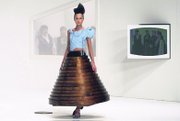New MOCA Exhibit to Focus on Fashion and Architecture
The Museum of Contemporary Art in Los Angeles’ newest exhibit, “Skin + Bones: Parallel Practices in Fashion and Architecture,” explores how the two disciplines of fashion and architecture look to each other for a muse.
Brooke Hodge, MOCA curator of architecture and design, first noticed the parallels between fashion and architecture when she studied the work of Rei Kawakubo for Comme des Garccedil;ons.
“I started to notice how architects were borrowing techniques from fashion or dressmaking— like pleating, folding, wrapping, draping—in order to create complex surfaces,” Hodge said.
The exhibit focuses on fashions dating from 1980 to the present by designers and labels such as Azzedine Alaia, Hussein Chalayan, Comme des Garccedil;ons, Alber Elbaz for Lanvin, Tess Giberson, Yoshiki Hishinuma, Maison Martin Margiela, Alexander Mc- Queen, Issey Miyake, Narciso Rodriguez, Ralph Rucci, Nanni Strada, Yeohlee Teng, Olivier Theyskens for Rochas, Isabel Toledo, Dries Van Noten, Viktor & Rolf, Junya Watanabe, Vivienne Westwood, Yohji Yamamoto and J. Meejin Yoon for My Studio. Architects and firms including Herzog & De Meuron, Shigeru Ban Architects, Frank Gehry, Rem Koolhaus for OMA, Zaha Hadid, Greg Lynn Form, Preston Scott Cohen and Foreign Office Architects will also be on display.
The exhibit is organized by the themes “identity,” “shelter” and “tectonic strategies” such as folding and draping.
Most of the artists featured work within their own discipline, and Hodge illustrates how designers and architects borrow ideas from each other. Some subjects, such as Los Angeles–based Elena Manferdini, blur the line between architecture and fashion.
Hodge said that Manferdini, an architect– turned–fashion designer, applies the process of architecture design to a computer program, which she then uses to create fashions.
“For our show, I showed [Manferdini] the mannequins that we’re using,” Hodge said. “So she constructs the mannequin on the computer, and she creates the dress on that form using 3D modeling on the computer. Then she flattens the dress out and programs her laser cutter so it cuts out pieces based on the construction on the computer.” Manferdini then finishes off the designs with sewing and handwork.
Both fashion and architecture share the same starting point for design: the human body. Hodge interpreted the idea of the body, whether on a personal scale or as an outside structure for many people, as the inspiration for the title “Skin + Bones.”
“The skin is the surface, and the bones are the structure,” she said. “[Both fashion and architecture are] based on the scale of the body, and also both of them are a means of protecting and sheltering people.”
“Skin and Bones: Parallel Practices in Fashion and Architecture” runs from Nov. 19 through March 5 at MOCA’s principal location at 250 S. Grand Ave. For more information, visit www.moca.org or call (213) 626-6222. —Rhea Cortado






















